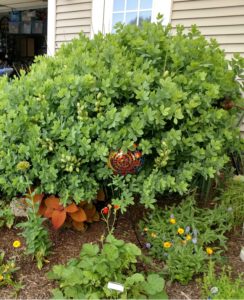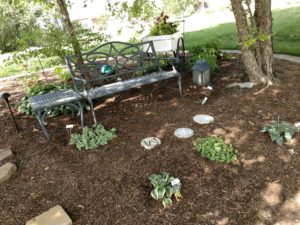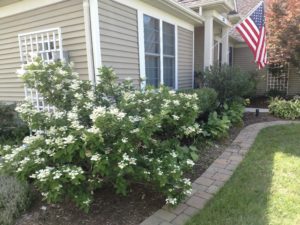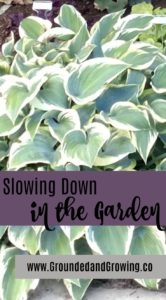Is your gardening time just another chore on your to-do list? The “slow gardening” approach can change your perspective and help you enjoy your garden for a change.
This post contains affiliate links for your convenience. I only promote products I love.
The last time someone asked “How are you?” how did you respond?
“Crazy busy!” ~ “Running from one thing to the next!” ~ “Meeting myself coming and going!”
I’ve said every single one of these statements in the last week. I’ve slowed down a lot in recent years, but the temptation to cram more into our schedule is ever present.
It’s like some modern badge of achievement. No one seems to have time for anything anymore. We are perpetually busy. More and more places offer online ordering and curbside pickup. I even saw a commercial recently for an app where you can pre-order your popcorn at the movies and pick it up as you arrive!
Modern technology lets us cram an incredible amount of activity into a single day, even a single moment—multi-tasking has become the norm for many. But science tells us our brains can only do one thing at a time effectively. Yet the messages linger that say are we are not productive citizens unless we are trying to do multiple things at once.
It’s all too easy to let this frenzied multitasking mindset creep into our gardens, the very place we are supposed to find peace, relaxation and connect with nature’s slower pace.
Have you ever looked at your garden and heard a ‘to-do’ list forming in your head?
I know I have.
Just when I was starting to recognize the multitasking monster creeping into my garden, I met gardening author Felder Rushing. He is an author and presenter like no other. To say he is unique is an understatement.
As a now former Extension employee I loved the portion of his talk where he said something like “I don’t work for Extension anymore so now I can tell you what I really think and do in my garden”. He spent his Extension career as a turfgrass specialist. And he has very little grass in his own yard. So that should tell you something.
He coined the phrase “slow gardening” and wrote a book by the same name to encourage a more relaxed approach to gardening. I immediately bought my copy directly from Felder after hearing his lecture on the topic. I read parts of it but I could never find the time to read the whole book– which in itself seemed to slap me in the face with a larger problem.
I couldn’t seem to slow down any part of my life, let alone gardening. And I was exhausted. In time I took drastic measures which I wrote about in this post.
Truth be told I have finally slowed down enough to read his book cover-to-cover and I love it more than ever.
Felder tells us that “slow gardening isn’t lazy or passive gardening—it actually involves doing more stuff, carefully selected to be productive without senseless, repetitive chores.” Slow gardening invites us to appreciate the rhythm of the seasons, choose plants most appropriate for local conditions, and to sit back and ENJOY our gardens.

When’s the last time you sat back in your yard and let yourself really relax?
A few rules of thumb for slow gardening
- Think in terms of gardening for the “long haul” and finding ways to ways to “take it easy” in your garden. How can you make your yard less like work and more like an escape from the hamster wheel of modern life?
- Consider how you plant and maintain your garden. Rather than cramming as much activity as humanly possible into the all too brief weekend, what if you spread your gardening out, doing a little each day? Imagine how it would feel to have time to enjoy and observe your garden rather than reducing it to another item checked off your ‘to-do’ list.
- Another fundamental concept of slow gardening is “right plant, right place.” In other words, choose pest- and disease-resistant plants that are well adapted to local climate and soils. This might mean planting more native plants, but this concept also includes planting new varieties bred to require little maintenance.

Blue False Indigo, Baptisia australis is an easy-maintenance native plant.
- A natural result of selecting plants well adapted to local conditions is less use of pesticides. Less use of pesticides may lead to more birds and butterflies visiting your garden.
- Slow gardening also encourages us to plant food crops in our gardens. This doesn’t necessarily mean creating a large vegetable garden. Peppers or tomatoes planted in a sunny flower garden, some herbs outside the kitchen door, or a pot of lettuce on the patio all count. Although it’s possible to buy just about any sort of produce year-round in supermarkets, this produce will never taste as good as what grows in your backyard. Try it and see.
Walking the Talk
I love the concept of slow gardening, but I struggled to put it into practice until I had my son in 2013. As a new mom, if I had an opportunity to garden, it was only in little bits of time here and there, and some things I “always” did just couldn’t get done. I looked at my garden and just felt sad and guilty. And I had trouble just enjoying time out in the garden without seeing all the things I thought needed to be done.

I never actually sat on this bench in my garden until after my son was born in 2013. I spent many an afternoon with him in the shade of the birch trees on this bench. Nothing soothed him (or me for that matter) more than the shifting patterns of leaves overhead.
After our second child arrived in 2016, I had started to adopt a new “normal” for a lower maintenance garden, but the enjoyment factor was still missing. I was always hustling to check off more tasks.
I can sense my gardening style shifting. Much like I’ve been working on decluttering my house, I’ve been decluttering the garden to be able to adopt a “slow gardening” approach. I’m using more native plants adapted to our region. I’m eliminating fussy plants that need constant babying. I have to fight my inner plant addict that wants to plant All. The. Plants.
But slowly a calmer space that doesn’t just shout “This needs deadheading!” is emerging.

This Hydrangea paniculata ‘Quick Fire’ is a gorgeous modern cultivar that is a reliable bloomer, unlike some other hydrangeas. The flowers start out white and age to pink and red.
My time in the garden has also become more enjoyable thanks to the eyes of my children. This year we expanded our bird and butterfly gardening efforts and each meal we watch intently from our kitchen table to see who’s visiting the garden. With any luck we’ll convince the local hummingbirds to drink out of our handheld feeders we bought recently. The other day we played that we were pirates “walking the plank” on some rocks near our backyard stream.
I’ll take this newfound “slow garden” over my former fussy garden any day. Where can you find some “slow time” in your garden?
If you liked this post, please subscribe to Grounded and Growing today and receive your copy of “15 Tips to Become a '15 Minute Gardener'” so you can spend less time working ON your garden and more time enjoying being IN your garden.! It’s absolutely free. When you join the Grounded and Growing community, you’ll finally take the garden off your “To-Do” list and allow yourself time to enjoy your garden and savor the peace and serenity there. I tell subscribers about new posts as soon as I hit ‘publish’ and send weekly-ish updates on what’s going on in my garden– good, bad AND ugly.

All Rights Reserved. © 2018 Jennifer Schultz Nelson.
Once again you speak to my heart! My garden is neglected because I can’t spend enough time there. I think of giving it up but I love planning, planting and harvesting. Your words are so encouraging and a friend just told me about an organic substance to fight the nasty grass choking mt garden!
Thank you for opening your garden for the walk tomorrow.
Thank you so much for your kind words Cheryl. I’m glad my words could help show you you’re not alone! Please keep on gardening, even if you have to scale back for awhile. That will help keep you in love with your garden, rather than looking at it as a chore!